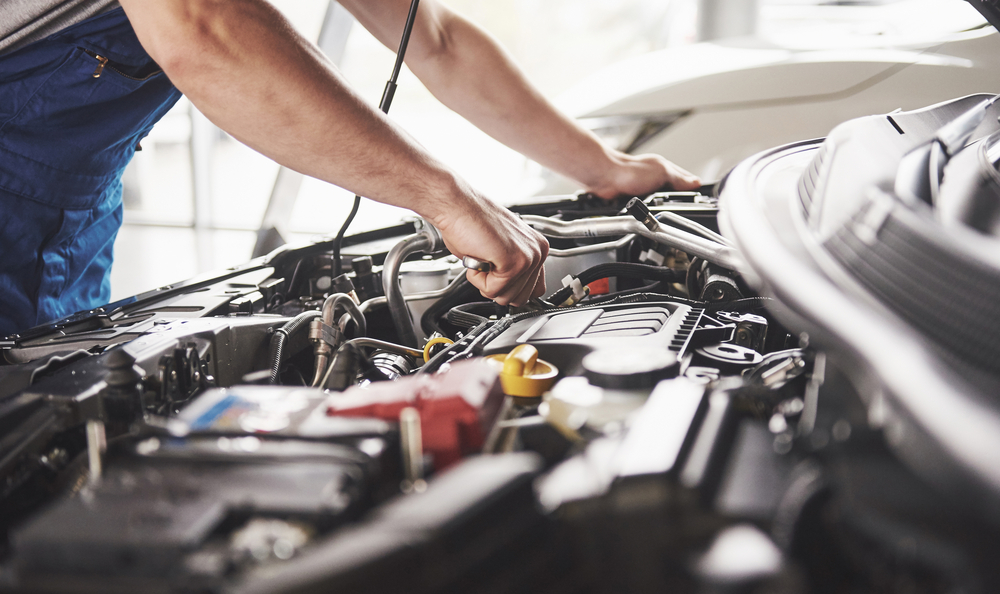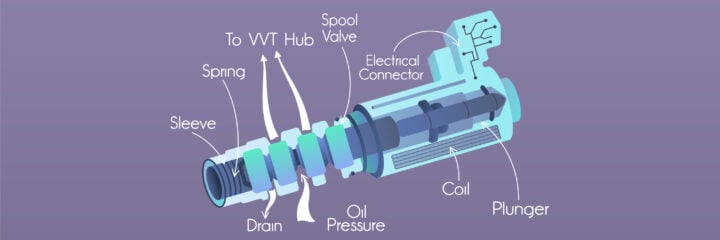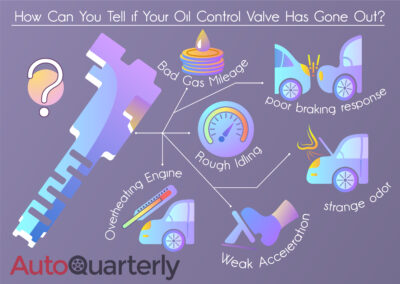Cars and teenagers have one thing in common: quarts of oil coursing through them at all times. Unlike teenagers, though, cars have a mechanism inside them designed to control the flow of that oil.
That mechanism is the oil control valve, and if it goes out, it can be very bad news for your engine. In our guide below, we’ll explain what your oil control valve does, how to know when it’s on its last legs, and how much replacing it will cost.
Don’t ask us to explain your teenager to you, though. We recommend replacing one of those with a newer model at the earliest opportunity.
- What Does the Oil Control Valve Do?
- What Causes an Oil Control Valve to Fail?
- How Can You Tell if Your Oil Control Valve Has Gone Out?
- How Much Will It Cost to Have a Faulty Oil Control Valve Replaced?
- Can You Replace Your Oil Control Valve Yourself?
- Is It Safe to Drive a Car With a Faulty Oil Control Valve?
- How Can You Prevent Your Oil Control Valve From Failing?
- Final Thoughts
What Does the Oil Control Valve Do?
The name should give you a pretty big clue as to the oil control valve’s function: it controls the flow of oil inside your engine. It’s also known as a “variable valve time” (VVT) solenoid, which tells you almost nothing about its intended purpose.
It’s connected to your engine control module (ECM). The ECM is actually what decides how much oil goes into the camshaft at any given time, and it directs the oil control valve to open or close accordingly.
As long as both your ECM and oil control valve are doing their jobs, your camshaft will always have precisely the right amount of oil inside it. If either one kicks the bucket, though, your engine could be in for some rough times, indeed.
What Causes an Oil Control Valve to Fail?

There are any number of reasons why an oil control valve can go bad, but some are more likely than others.
The most common culprit is old oil. The longer oil is kept in your engine, the more debris and other gunk it will accumulate, causing it to become thick and sludgy. Once it gets to this point, it can clog up the oil control valve, damaging it in the process.
Wear and tear is another common reason for these parts to fail. Eventually, of course, every part will fail, your body will break down and wither away into nothingness, the universe will plunge into heat death, life as we know it will cease, and all machinery will lie forgotten and in disrepair…
Mostly, though, it’s old oil that you have to worry about.
Oil control valves can be tricky parts, in that they don’t really have a set lifespan. If you’re changing your oil regularly and keeping up on other maintenance, your oil control valve might never go out.
However, if you’re trying to set a record for most time between oil changes, your oil control valve could go out at any time — even in a relatively new car. You’re not likely to get much warning beforehand, so it behooves you to take care of your car so that you don’t have to worry about this happening.
How Can You Tell if Your Oil Control Valve Has Gone Out?
As you might already know, oil is essential to an engine’s proper operation (thanks for coming to our TED talk). As a result, there are a variety of symptoms that can crop up once your oil control valve goes out.
Typically, as with many other engine problems, the first thing that you’ll notice is your check engine light coming on. Your onboard computer will recognize an issue with the valve, and it will fire up a warning light to let you know that something’s wrong.
If you’re the type who ignores check engine lights, you may notice some other signs, such as:
Weak Acceleration
Your car might accelerate sluggishly, as the flow of oil will suddenly become unreliable. Your engine won’t be able to handle the lack of oil, causing it to lose power when you step on the gas.
You may also be limited in how fast you can go. You may not be able to get your car to go faster than 40 or 50 mph, for example.
Bad Gas Mileage
Poor fuel economy is another telltale sign of a faulty oil control valve. The ECM and oil control valve combine to ensure that your engine is running as efficiently as possible; if either one of them goes out, the timing of your engine will be thrown off, causing your car to consume more gas than usual.
Overheating Engine
Oil’s main purpose is to reduce friction between the components of your engine, so if your motor suddenly isn’t getting any lubrication, it will start to get hot. This is usually the symptom that owners find the hardest to ignore.
Rough Idling
If your car’s RPM increases, it’s a sign that it’s having to work harder for some reason. In this case, it’s having to overcompensate for an inconsistent oil supply, so you may see your RPMs spike and drop for no good reason, even when the car isn’t in motion.
Other symptoms include poor braking response and a strange odor emanating from the engine.
The issue with all of this, of course, is that these are also common symptoms of other issues with your engine. You may not be able to pinpoint the oil control valve as the culprit without taking your car into the shop and having a mechanic take a peek underneath the hood.
How Much Will It Cost to Have a Faulty Oil Control Valve Replaced?

Given the important role an oil control valve plays in your car’s operation, you might suspect that replacing one could cost an arm and a leg. That’s not the case, though, as it’s actually a relatively affordable procedure.
Notice we said “relatively.” It will likely still cost a few hundred bucks — usually between $200 and $600, to be exact. The valves themselves cost between $100 and $400, and you’ll usually tack on an hour or two of labor, as well.
As with any car repair, though, those costs can vary. If you have a high-end car, it may be more expensive to replace the valve, and some mechanics will charge more or less per hour in terms of labor.
Some shops will also charge a diagnostic fee to determine the cause of the problem. This fee will most likely be in the $50 to $100 range.
They may also recommend flushing the engine lubrication system to get rid of any of the sludge or gunk (these are technical terms) that caused the valve to fail in the first place. This flushing will cost around $125 or so, and you’ll also get new oil and a new oil filter out of the deal.
Can You Replace Your Oil Control Valve Yourself?
If you’re pretty handy with a wrench and want to save a few hundred bucks, you can always try to replace the valve yourself.
Given how important this particular part is, though, we wouldn’t recommend doing this unless you’re absolutely sure you know what you’re doing (or if you really hate your car).
If you screw it up, you could deprive your engine of oil or drown it with lubrication, neither of which are ideal for the long-term health of your ride.
The steps involved in replacing the oil control valve will vary from car to car, so consult your owner’s manual before beginning (or, you know, YouTube it).
Is It Safe to Drive a Car With a Faulty Oil Control Valve?
If you suspect that your oil control valve has gone out, we wouldn’t recommend driving your car any more than is absolutely necessary. Your best bet is to just drive it to your mechanic’s garage and leave it there.
The fact that it can affect your ability to brake and accelerate effectively makes driving your car dangerous, if not downright reckless. The last thing you want is to get into a serious accident just because you were driving a faulty piece of machinery.
Even if you don’t care about your health and safety, surely you care about your car? You’re putting it at risk by driving it when you know it will receive an unreliable oil supply. Your car could overheat, damaging all sorts of parts in the process.
If that happens, a relatively manageable repair could suddenly become a massive job — complete with a massive bill.
You’ll be much better off by staying off the roads as much as you can.
How Can You Prevent Your Oil Control Valve From Failing?
You’ve probably heard the old saying, “An ounce of prevention is better than spending hundreds of dollars at your mechanic’s.” It’s especially true in this case — and while it’s impossible to completely protect your oil control valve from breaking down, there are a few things you can do to make it less likely to happen.
By far the most important thing to do is get your oil changed regularly. By keeping clean oil in the engine, you’ll reduce the buildup of sludge. As we’ve already discussed, sludge is one of the most common causes of an oil control valve failing, so anything you can do to minimize it is a good thing.
Investing in a higher-quality oil is probably a good idea, too. High-quality oil does a better job of lubricating the components inside your engine, lessening wear and tear on everything (including the oil control valve).
Good oil is also better at handling dirt, grime, and anything else that can penetrate the inner workings of your engine. Make no mistake, even the best oil can turn into sludge eventually, but higher-quality oil will last a lot longer before it goes bad.
Final Thoughts

An oil control valve is a lot like the ozone layer: very few people know what it is or what it does, but if it goes out, we’re all dead.
Okay, so maybe things aren’t that drastic in regards to your oil control valve, but the fact of the matter remains that it’s bad news if it fails.
That’s why it’s so important to perform regular maintenance on your car, as it can mean the difference between having a reliable form of transportation and an expensive paperweight.
Or you can just roll the dice and see how long your car can last without an oil change. After all, if the last 120 years have taught us anything, it’s that oil really isn’t that big of a deal.



